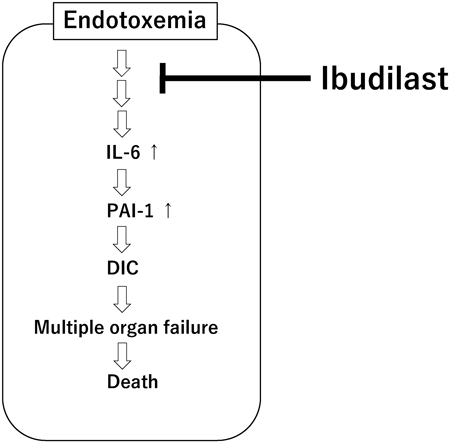3 0 0 0 OA Ibudilast Reduces IL-6 Levels and Ameliorates Symptoms in Lipopolysaccharide-Induced Sepsis Mice
- 著者
- Naoko Kadota Akari Yoshida Atsushi Sawamoto Satoshi Okuyama Mitsunari Nakajima
- 出版者
- The Pharmaceutical Society of Japan
- 雑誌
- Biological and Pharmaceutical Bulletin (ISSN:09186158)
- 巻号頁・発行日
- vol.45, no.8, pp.1180-1184, 2022-08-01 (Released:2022-08-01)
- 参考文献数
- 30
- 被引用文献数
- 1
In Japan, ibudilast (IBD) is a therapeutic agent used to treat asthma, allergic conjunctivitis, and dizziness caused by cerebrovascular disease. Previously, we have reported that IBD could reduce the secretion of proinflammatory cytokines, including interleukin (IL)-6 and tumor necrosis factor (TNF)-α, in lipopolysaccharide (LPS)-treated RAW264.7 monocyte-linage cells in vitro. In the present study, we examined the anti-inflammatory effects of IBD in vivo. As IL-6 is a biomarker for sepsis and has been suggested to exacerbate symptoms, we determined whether IBD reduces IL-6 levels in vivo and improves sepsis symptoms in animal models. We observed that IBD treatment reduced IL-6 levels in the lungs of LPS-treated mice and improved LPS-induced hypothermia, one of the symptoms of sepsis. In addition, IBD reduced IL-6 and attenuated plasminogen activator inhibitor-1 (PAI-1) and alanine aminotransferase (ALT) levels in the serum of LPS-treated mice. Elevated PAI-1 levels exacerbate sepsis-induced disseminated intravascular coagulation (DIC), and ALT is a biomarker for liver dysfunction. IBD improved the survival of mice administered a lethal dose of LPS. IBD administration ameliorated kidney pathology of model mice. Overall, these results suggest that IBD exerts anti-inflammatory functions in vivo and could be a drug candidate for treating endotoxemia, including sepsis.
- 著者
- Shouma Ishikawa Atsushi Sawamoto Satoshi Okuyama Mitsunari Nakajima
- 出版者
- The Pharmaceutical Society of Japan
- 雑誌
- Biological and Pharmaceutical Bulletin (ISSN:09186158)
- 巻号頁・発行日
- vol.44, no.4, pp.550-556, 2021-04-01 (Released:2021-04-01)
- 参考文献数
- 23
- 被引用文献数
- 3
We previously reported a screening method for caloric restriction mimetics (CRM), a group of plant-derived compounds capable of inducing good health and longevity. In the present study, we explored the possibility of using this method to screen CRM drugs for drug repositioning. The method, T-cell activation-inhibitory assay, is based on inductive logic. Most of CRM such as resveratrol have been reported to suppress T-cell activation and have anti-inflammatory functions. Here, we assessed the activity of 12 antiallergic drugs through T-cell activation-inhibitory assay and selected four that showed the lowest IC50 values—ibudilast (IC50 0.97 µM), azelastine (IC50 7.2 µM), epinastine (IC50 16 µM), and amlexanox (IC50 33 µM)—for further investigation. Because azelastine showed high cytotoxicity, we selected only the remaining three drugs to study their biological functions. We found that all the three drugs suppressed the expression of interleukin (IL)-6, an inflammatory cytokine, in lipopolysaccharide-treated macrophage cells, with ibudilast being the strongest suppressor. Ibudilast also suppressed the secretion of another inflammatory cytokine, tumor necrosis factor (TNF)-α, and the expression of an inflammatory enzyme, cyclooxygenase-2, in the cells. These results suggest that T-cell activation-inhibitory assay can be used to screen potential CRM drugs having anti-inflammatory functions for the purpose of drug repositioning.
- 著者
- Yoshiko Furukawa Satoshi Okuyama Yoshiaki Amakura Atsushi Sawamoto Mitsunari Nakajima Morio Yoshimura Michiya Igase Naohiro Fukuda Takahisa Tamai Takashi Yoshida
- 出版者
- The Pharmaceutical Society of Japan
- 雑誌
- Chemical and Pharmaceutical Bulletin (ISSN:00092363)
- 巻号頁・発行日
- vol.69, no.1, pp.2-10, 2021-01-01 (Released:2021-01-01)
- 参考文献数
- 74
- 被引用文献数
- 7
The elderly experience numerous physiological alterations. In the brain, aging causes degeneration or loss of distinct populations of neurons, resulting in declining cognitive function, locomotor capability, etc. The pathogenic factors of such neurodegeneration are oxidative stress, mitochondrial dysfunction, inflammation, reduced energy homeostatis, decreased levels of neurotrophic factor, etc. On the other hand, numerous studies have investigated various biologically active substances in fruit and vegetables. We focused on the peel of citrus fruit to search for neuroprotective components and found that: 1) 3,5,6,7,8,3′,4′-heptamethoxyflavone (HMF) and auraptene (AUR) in the peel of Kawachi Bankan (Citrus kawachiensis) exert neuroprotective effects; 2) both HMF and AUR can pass through the blood–brain barrier, suggesting that they act directly in the brain; 3) the content of AUR in the peel of K. Bankan was exceptionally high, and consequently the oral administration of the dried peel powder of K. Bankan exerts neuroprotective effects; and 4) intake of K. Bankan juice, which was enriched in AUR by adding peel paste to the raw juice, contributed to the prevention of cognitive dysfunction in aged healthy volunteers. This review summarizes our studies in terms of the isolation/characterization of HMF and AUR in K. Bankan peel, analysis of their actions in the brain, mechanisms of their actions, and trials to develop food that retains their functions.


